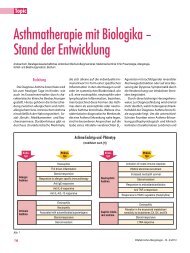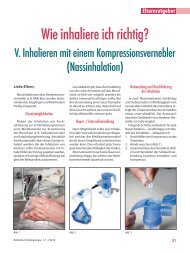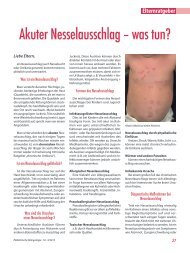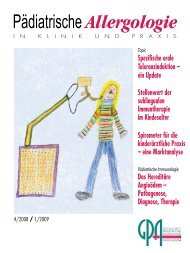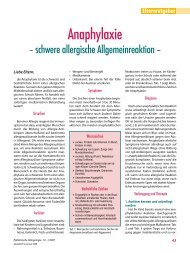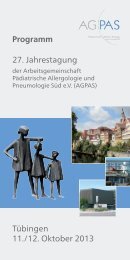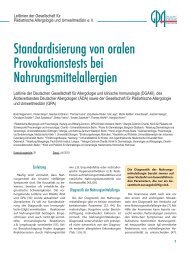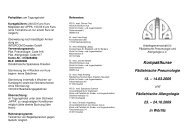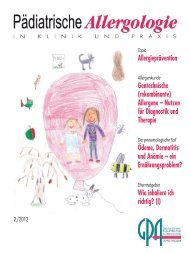Gesellschaft für Pädiatrische Allergologie und Umweltmedizin
Gesellschaft für Pädiatrische Allergologie und Umweltmedizin
Gesellschaft für Pädiatrische Allergologie und Umweltmedizin
Sie wollen auch ein ePaper? Erhöhen Sie die Reichweite Ihrer Titel.
YUMPU macht aus Druck-PDFs automatisch weboptimierte ePaper, die Google liebt.
diese Studie deutlich, dass die Allergiepräventionsberatung<br />
mit zunehmender<br />
Kenntnis der immunologischen Zusammenhänge<br />
nicht leichter wird <strong>und</strong> es<br />
möglicherweise in Zukunft noch sinnvoller<br />
ist, auf allgemeine weit reichende<br />
Empfehlungen zu verzichten <strong>und</strong> stattdessen<br />
nur individuelle, auf die Familie,<br />
die Mutter oder das Kind zugeschnittene<br />
zu geben. Es darf auch nicht aus dem Augen<br />
verloren werden, dass die Präventionsempfehlungen<br />
<strong>für</strong> die Betroffenen<br />
umsetzbar bleiben müssen, ohne dass<br />
sich die Lebensqualität <strong>und</strong> die ausreichende<br />
Nährstoffversorgung <strong>für</strong> Mutter<br />
<strong>und</strong> Kind drastisch verschlechtern sowie<br />
der psychische Druck zu neuen Problemen<br />
führt.<br />
Dr. Sabine Schmidt<br />
Kinderumwelt gGmbH<br />
Westerbreite 7, 49084 Osnabrück<br />
Tel.: 0541-9778-900<br />
Fax: 0541-9778-905<br />
E-Mail: sschmidt@uminfo.de<br />
Hoppu U, Kallimäki M, Isolauri E (2002).<br />
Cow’s milk allergy – a matter of fat. Allergy<br />
57; 1: 61-62 (Kurzmitteilung AllergyNet)<br />
Elimination of cow s milk from the breastfeeding<br />
mother’s diet is an approach commonly<br />
used in attempts to prevent allergic disease<br />
in infants. Results, especially long-term,<br />
have often been conflicting and disappointing.<br />
One explanation may be that previous studies<br />
have concentrated qualitatively, not quantitatively,<br />
on allergenic proteins in the diet, and<br />
not on other dietary factors with immunomodulatory<br />
properties such as dietary fatty<br />
acids. Specific polyunsaturated fatty acids<br />
have been shown to be associated with promotion<br />
on one hand and prevention on the<br />
other of allergic inflammation. We therefore<br />
now determine maternal intakes of cow’s milk<br />
protein and fat during breastfeeding and evaluate<br />
their effects on the infant’s sensitization<br />
to cow’s milk and the incidence of cow’s milk<br />
allergy (CMA). Altogether 114 infants with a<br />
family history of allergic disease, who had<br />
been breastfed for at least three months, were<br />
rollowed up during their first year of life. The<br />
mothers complied a four day record of food<br />
intake when the infants were 3 months old.<br />
Nutrient intakes were calculated using Nutrica<br />
software (Research Center of the Social Insurance<br />
Institution, Turku, Finland). The infants<br />
were clinically examined at 3, 6 and 12<br />
months of age and skin prick tests (SPT) were<br />
performed at 12 months of age as previously<br />
described. In the case of symptoms suggestive<br />
of food allergy, double-blind, placebo controlled<br />
challenges followed by open consumption<br />
were carried out. Sensitization to cow’s<br />
milk was defined as a positive SPT reaction to<br />
milk, and cow’s milk allergy (CMA) as positive<br />
to cow’s milk challenge. Results are given as<br />
means with 95% confidence interval (Cl) in<br />
parentheses.<br />
Positive skin prick test reactivity to milk was<br />
detected in 7/114 (6%) infants. A total of<br />
15/114 (13%) infants had challenge proven<br />
cow’s milk allergy. The mean age at diagnosis<br />
of CMA was 7.2 (5.9-8.5) months. The mean<br />
duration of breastfeeding was exclusively 3.3<br />
(3.0-3.6) and overall 7.7 (7.1-8.3) months and<br />
was comparable in infants with and without<br />
positive SPT or challenge.<br />
The mean energy intake of the mothers was<br />
8.0 (7.7-8.3), MJ/day. Maternal intake of cow’s<br />
milk protein ranged from 1.9 to 63.1 g/day,<br />
mean 26.2 (24.0-28.3) g/day and, adjusted for<br />
energy intake, 3.3 (3.0-3.5) g/MJ/day. The<br />
mean proportion of energy derived from fat<br />
was 36.6 (35.6-37.6) E% and from saturated<br />
fatty acids 15.8 (15.2-16.3) E%. Maternal intake<br />
of cow’s milk protein was not associated<br />
with SPT reaction to milk or CMA in the infant.<br />
In contrast, high intakes of total fat and saturated<br />
fatty acids were associated with sensitization<br />
to milk.<br />
Our result indicates that sensitization to food<br />
allergens may not depend directly on the absolute<br />
amount of allergenic proteins in the<br />
diet, but rather on a complexity of dietary determinants.<br />
The Western diet typically contains<br />
an ab<strong>und</strong>ance of fat, especially saturated<br />
fatty acids, and the prevalence of allergic<br />
disease is highest in Western societies. It<br />
would appear that breastfeeding mothers<br />
should perhaps reduce their fat intake rather<br />
than eliminate cow’s milk from their diet to<br />
prevent allergy in the infant.<br />
References<br />
1. Hattevig G, Sigurs N, Kjellman B (1999). Effects of<br />
maternal dietary avoidance during lactation on allergy<br />
in children at 10 years of age. Acta Paediatr 88: 7-12.<br />
2. Black PN, Sharpe S (1997). Dietaryfatandasthma –<br />
is there a connection? Eur Respir J 10: 6-12.<br />
3. Hoppu U, Kalliomaki M, Isolauri E (2000). Maternal<br />
diet rich in saturated fat during breastfeeding is associated<br />
with atopic sensitization of the infant. Eur J Clin<br />
Nutr 54: 702-705 .<br />
2/02 <strong>Pädiatrische</strong> <strong>Allergologie</strong> 27



